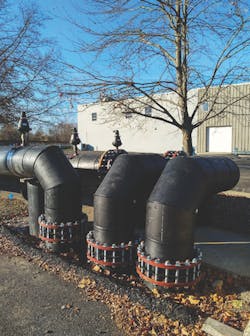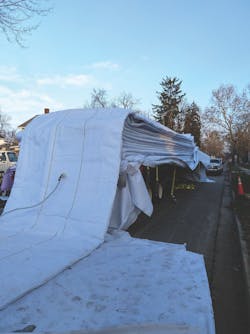About the author:
Arianna Berry is a freelance writer for Water & Wastes Digest. Berry can be reached at [email protected] or 904.451.1565.
The public may never know the disaster that could have been had Fort Wayne not taken a proactive approach to rehabilitate the city’s aging sewer infrastructure. But what it does know is the effort it took for the city to pull off one of its most ambitious sewer lining projects to date: the St. Joe Interceptor Rehabilitation.
Fort Wayne’s Sewer Pipes
Concrete pipes are eventually corroded by the hydrogen sulfide gas naturally emitted by sewage. When studies revealed some of their pipes to have been compromised in this way, the city of Fort Wayne knew it had to be proactive. So, it set a goal to implement liners when pipes are partially (but not fully) deteriorated, a proactive rehabilitation approach that can add 50 to 75 years to the life of the pipe.
Frank Suarez, Fort Wayne utilities director of public information, highlighted how vital the work is.
“The work may not be glamorous,” Suarez admitted, “but for decades, utility infrastructure has been under-invested in nationwide. Now we look for cost-effective ways to make repairs and extend the life of pipes, and that’s how the lining projects started.”
When Fort Wayne began its major rehab program in 1998, the lining technology was still new. However, by 2015, the liners were holding up well, so it ramped up funding, and the average number of miles lined annually jumped from 11 to 15. To date, Fort Wayne has lined 260 of more than 1,400 total miles of sewer pipes with diameters ranging from 8 to 120 inches. By feeding cameras mounted with sonar devices through the pipes, the city can proactively identify damage before it is too late.
In 2015 this special televising process revealed that the large St. Joe interceptor’s pipe had corroded enough to expose the underlying structural rebar. A GIS map traced upstream calculated how many neighborhoods the line impacted: conservatively, a third of the city. So the stakes were high as they began designing the repair.
How it Started
Typically, a highly specialized project like this might only receive a couple of bids, so when four bids were received, Project Manager Eric Steinman — also an engineer for the Fort Wayne Sewer Rehabilitation Design & Construction team — was pleased. The winning bid came in under the engineer’s estimate and from a company with whom Fort Wayne had successfully worked before: Insituform. While the city had partnered previously on lining pipes of varying diameters, the St. Joe Interceptor project presented some unique challenges.
This was Fort Wayne’s first time lining a sewer anywhere close to this diameter. At 7-feet-wide by 7-feet-tall, the pipe was almost double the size of previous projects and demanded a considerable bypass to remain operational during the repairs.
Additionally, the soil boring tests conducted revealed the sandy soil so common near riverbeds. Personnel who installed the original pipe in the 1970s still talked about how difficult the soil had made installation all those years ago.
In preparation for the project, the team visited other cities and sought insight from large-diameter lining contractors. Design consultants Wessler Engineering had executed similar designs, which contributed to Fort Wayne’s confidence that the team was experienced enough to mitigate the risks.
Steinman’s biggest concern was the large pump bypass installation design, but ultimately, they managed to avoid trenching by tucking the pipes next to a levy wall above ground.
However, they found that the standard 24-inch manholes needed to be expanded to accommodate the 84-inch pipe’s large liner. Moreover, even digging only at the manholes proved challenging as heavy rains contributed to groundwater that moved through the sandy soil.
“Nine times out of 10, the small pump works perfectly,” Steinman reflected, but this time standard ports were ineffective in dropping water levels.
They adapted. They took a new approach to the manhole construction and stabilized the ground underneath with steel pilings similar to those used to support bridges. Still, the delays led to the busy street’s reopening being postponed three times. They found themselves learning a lot about managing community expectations as they held a neighborhood meeting and worked closely with the media to get new information out as developments progressed. As construction team members went out on Saturdays to make sure that barricades had not been moved overnight, they would also visit passers-by to make sure they understood what was going on and why the intersection remained closed.
While downtown workers and business customers were frustrated that their favorite thoroughfare was unavailable, neighborhood residents thoroughly enjoyed the reduced traffic. This particular neighborhood also seemed to understand that these infrastructure updates were critical to protecting their cherished river. There was another reason the community remained patient, though: how much worse the disruption would be if the pipe had been allowed to fail.
Approximately one-third of Fort Wayne’s sewage goes through that one pipe, and if it failed, there would be hundreds of basements backed up with sewage. Nobody would be able to flush their toilets. Utilities would be disrupted as the entire street length would be trenched 20-feet deep and closed for many months longer. Fort Wayne helped the community to understand that this project was the less disruptive option.
Designing an 84-inch Liner
Typically, a liner is made in a factory and shipped to the installation site. However, a prefabricated liner for an 84-inch diameter pipe is so heavy that even if it were not too wide to fit, flattened, on a semi-truck bed (which it is), it would not even be allowed on highways.
So, deconstructed liner components were shipped to the site separately. First, they brought in a truck full of resin that resembled a gasoline tanker. Then they completed the setup onsite by applying the resin to the resonance side of the liner. It was a large operation that required space, careful logistical planning, and respectful consideration of nearby residents.
During the installation, Insituform identified one small portion of the liner that did not cure, but corrected it by using a product made by fellow Aegion Corp. subsidiary, Fibrwrap. To have lined the entire sewer with the fiber-reinforced polymer product would have cost millions more, but it was an excellent solution for the small patch.
How This Project Was Different
The sheer novelty of lining such a massive pipe immediately differentiated the project from others.
“Right before I came on with our sewer rehab team almost 10 years ago, they had just finished that 48-inch liner,” Steinman said. “I think people would have laughed if we told them back then, ‘Hey, we’re going to put a liner into an 84-inch pipe.’ Technology’s come a long way. For the city of Fort Wayne to successfully take on that big of a challenge, that’s what I’m most pleased with.”
Then there are the pumps: For other projects, bypass pumping uses a smaller trailer unit that can be rented locally. The St. Joe Interceptor is not a tiny pipe that can be pumped around easily. It takes multiple, massive pumps to move that kind of sewage.
The four pumps custom-built for this project (two primary and two back-ups) were more intricate than anything previously known to the involved parties, and they had to be manned 24 hours per day because a failure would have caused imminent sewage backups.
Project Success
Altogether, around 30 people worked on this project: city representatives, design consultants, inspectors, traffic engineers, contractors, subcontractors, and community residents.
While some project milestones were delayed, others came in ahead of schedule. Ultimately the project was finished on time.
Most Fort Wayne rehab projects involve small or medium diameter pipes and are in the $3 million range. The city spent less on asphalt restoration by avoiding trenching, and this large diameter pipe rehabilitation clocked in $77,000 under budget at $3.8 million.
In addition to protecting public health and safety, the St. Joe Interceptor Rehabilitation project prevented negative economic impacts by avoiding sewer backups for hundreds of houses and businesses. Had Fort Wayne needed to trench extensively, businesses would have been shut down for many months longer. These businesses (especially manufacturers) rely heavily on sewer service to remove the plants’ waste, a quality service essential to avoiding fines.
Fort Wayne City Utilities realized success with the St. Joe Interceptor Rehabilitation project by proactively identifying the concern, carefully planning, and through measured execution: victory on all counts.



